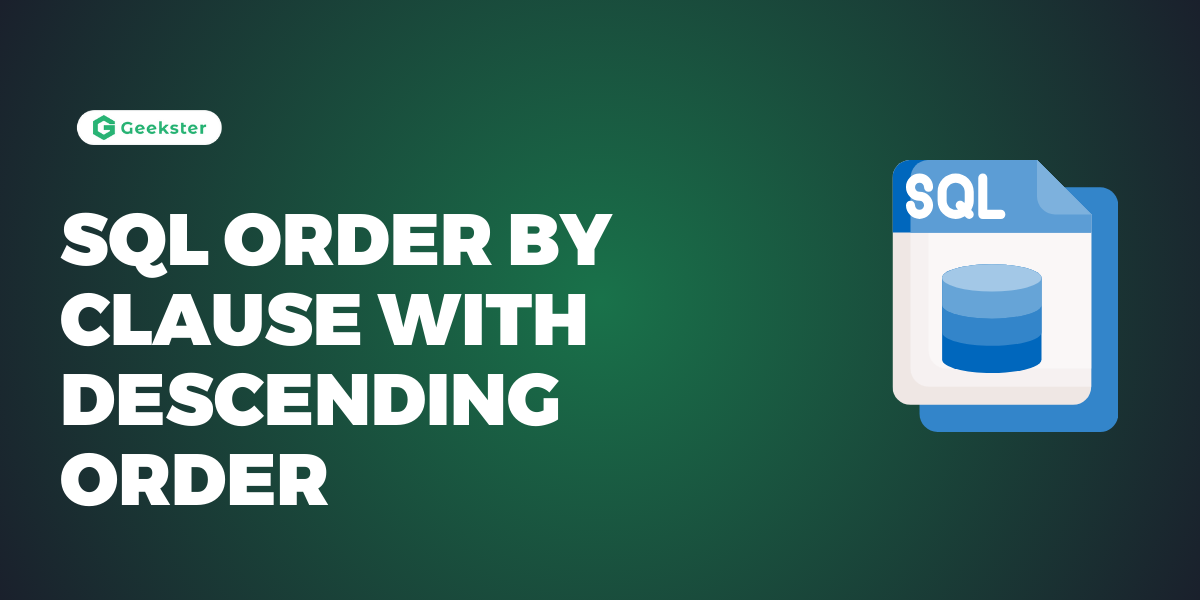In SQL, the ORDER BY clause is a fundamental component used to arrange the results of a query in a specified order. When retrieving data from a database, the order in which the results are presented can significantly impact the usability and readability of the information. The ORDER BY clause allows users to sort the rows returned by a SELECT statement based on one or more columns in either ascending or descending order.
Sorting data in ascending order, the default behaviour of the ORDER BY clause arranges the result set in an ascending sequence according to the values of the specified column(s). This means that the smallest values appear first, followed by progressively larger values. Understanding how to utilize the ORDER BY clause in ascending order is crucial for organizing query results in a structured and meaningful manner.
ORDER BY Clause with ASC
The SQL ORDER BY clause is used to sort the data in either ascending or descending order, based on one or more columns. This clause can sort data by a single column or by multiple columns. Sorting by multiple columns can be helpful when you need to sort data hierarchically, such as sorting by state, city, and then by the person’s name.
ORDER BY is used with the SQL SELECT statement and is usually specified after the WHERE, HAVING, and GROUP BY clauses.
Syntax
SELECT *FROM customers ORDER BY Name ASC; Examples of ORDER BY Clause with ASC
Example 1: Sorting by a Single Column Table: Employees
+-------------+------------+-----------+
| employee_id | first_name | last_name |
+-------------+------------+-----------+
| 10001 | John | Smith |
| 10002 | Emily | Johnson |
| 10003 | Michael | Williams |
+-------------+------------+-----------+
SELECT employee_id, first_name, last_name
FROM employees
ORDER BY last_name ASC;Output
+-------------+------------+-----------+
| employee_id | first_name | last_name |
+-------------+------------+-----------+
| 10002 | Emily | Johnson |
| 10001 | John | Smith |
| 10003 | Michael | Williams |
+-------------+------------+-----------+
Example 2: Sorting by Multiple Columns Table: products
+--------------+------------+-------+
| product_name | category | price |
+--------------+------------+-------+
| Laptop | Electronics| 1200 |
| Smartphone | Electronics| 800 |
| Shirt | Clothing | 30 |
+--------------+------------+-------+SELECT product_name, category, price
FROM products
ORDER BY category ASC, price ASC;
Output
+--------------+------------+-------+
| product_name | category | price |
+--------------+------------+-------+
| Shirt | Clothing | 30 |
| Laptop | Electronics| 800 |
| Smartphone | Electronics| 1200 |
+--------------+------------+-------+Example 3: Sorting Text and Numeric Data Table: students
+--------------+-----+
| student_name | age |
+--------------+-----+
| Alice | 20 |
| Bob | 22 |
| Claire | 20 |
+--------------+-----+SELECT student_name, age
FROM students
ORDER BY age ASC, student_name ASC;
Output
+--------------+-----+
| student_name | age |
+--------------+-----+
| Alice | 20 |
| Claire | 20 |
| Bob | 22 |
+--------------+-----+Example 4: Sorting Dates Table: orders
+-----------+------------+--------------+
| order_id | order_date | total_amount |
+-----------+------------+--------------+
| 1001 | 2024-04-25 | 1500 |
| 1002 | 2024-04-26 | 2000 |
| 1003 | 2024-04-27 | 1800 |
+-----------+------------+--------------+SELECT order_id, order_date, total_amount
FROM orders
ORDER BY order_date ASC;Output
+-----------+------------+--------------+
| order_id | order_date | total_amount |
+-----------+------------+--------------+
| 1001 | 2024-04-25 | 1500 |
| 1002 | 2024-04-26 | 2000 |
| 1003 | 2024-04-27 | 1800 |
+-----------+------------+--------------+Conclusion
In conclusion, the ORDER BY clause in SQL is a versatile tool for organizing query results in a specified order. When used with ASC (ascending order), it arranges the data in increasing sequence based on the specified column(s). Whether sorting by a single column, multiple columns, text, numeric data, or dates, the ORDER BY clause ensures that the results are presented in a structured and meaningful manner. By understanding and leveraging the power of the ORDER BY clause with ASC, SQL users can effectively manipulate and analyze data to meet their specific needs, improving the clarity and usability of their query results.
Frequently Asked Questions
The ORDER BY clause is used to sort the result set of a query in a specified order. It helps organize data according to certain criteria, making it easier to analyze and understand.
ASC stands for “ascending.” When used in the ORDER BY clause, it sorts data in ascending order, meaning the smallest values come first and then followed by progressively larger values.
Yes, you can sort the results by multiple columns using the ORDER BY clause with ASC. Simply list the columns you want to sort by, separating them with commas, and specify ASC after each column if ascending order is desired.
No, SQL does not guarantee any specific order for query results if the ORDER BY clause is not used. Without the ORDER BY clause, the database system may return the rows in an unpredictable order.
Yes, you can use column aliases in the ORDER BY clause. However, if the alias is derived from an expression or a function, some database systems might require you to use the original column name instead.

